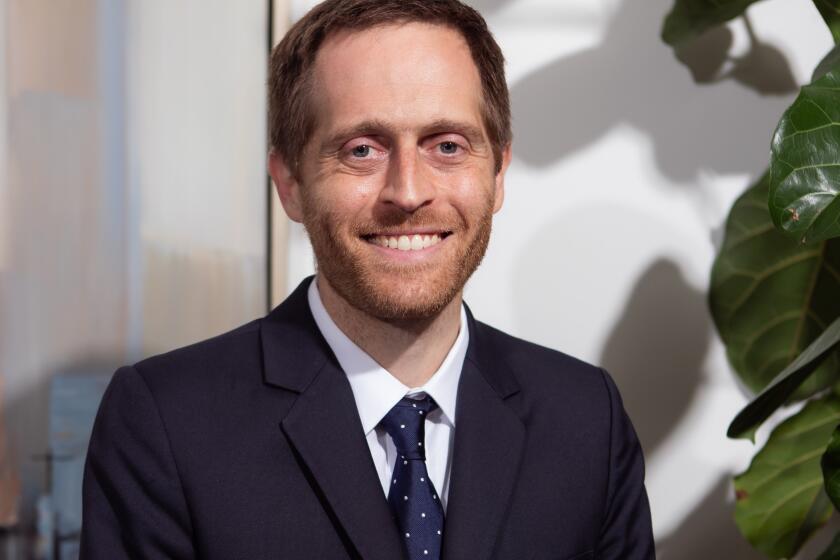Supervisor Recruited for Sespe : Environment: John K. Flynn calls criticism of Patagonia’s role ‘dirty politics’ and an attempt to deflect attention from the issue.
- Share via
Patagonia’s chief political strategist played a leading role behind the scenes in the events that led this week to Supervisor John K. Flynn’s appearance before a Senate subcommittee as a spokesman for a plan to protect the Sespe Creek.
Kevin Sweeney and other environmentalists actively recruited Flynn to be a lead spokesman for their battle to protect the Sespe Creek against future dams and win congressional “wild and scenic” status for Ventura County’s largest back-country river.
Sweeney and members of the Keep the Sespe Wild group also openly lobbied other members of the Board of Supervisors, Sweeney said. But Flynn was the preferred point man on the issue because of his wide knowledge of water issues.
At one point, Sweeney offered to fly Flynn to Washington using bonus mileage stamps that Sweeney had accrued from his own air travel. Flynn refused the offer, stating he believed such an act would be illegal.
Patagonia’s involvement brought charges Friday from opponents of Flynn’s Sespe Creek plan that the environmentally active clothing company was playing too strong a role in county politics. Flynn responded by charging his critics with engaging in “dirty politics.”
His trip to Washington will be paid for by the county, Flynn said. He called it a justifiable expense because the full Board of Supervisors voted 5 to 0 last week to support Flynn’s position on the Sespe.
Flynn said he met with Sweeney and others in the last four months while he worked to develop the plan he introduced last week as a compromise. Flynn said his views and those of Sweeney and Keep the Sespe Wild converge on this issue because both sides believe, for different reasons, that a dam on the Sespe is wrong.
But opponents of Flynn’s plan, which would essentially preclude any dams on the Sespe except small diversion-style dams on the river’s lower four miles, charged that Flynn’s alliance with Sweeney on the issue is another example of Patagonia’s strong hand in Ventura County politics.
“It’s a scary scenario that one company can play such a decisive role in several elections and in effect purchase political control,” said Carolyn Leavens, owner of one of the county’s largest ranching operations. “We can see Patagonia’s fingerprints all over this plan.”
Patagonia helped elect three Ventura City Council members two years ago and also supported Supervisor Maria VanderKolk in her upset win against incumbent Supervisor Madge Schaefer last year.
Flynn said he has not received any contributions from Patagonia, and that his opponents’ objections to Sweeney’s involvement in developing the plan are an attempt to deflect attention from the issue at hand.
“It’s dirty politics,” he said. “Building a dam on the Sespe is unrealistic. Our attention should be turned to importing state water and reclaiming waste water that could generate thousands of acre-feet of water a year.”
Flynn, Leavens and other Ventura County representatives spoke in Washington Thursday before a Senate subcommittee on the proposed Los Padres Wilderness bill.
Both the Senate and House versions of the bill designate nearly 400,000 acres of national forest as wilderness areas, including the 220,500-acre Sespe Wilderness in the county’s rugged back country. The bills also designate as wild and scenic or preserve for further study more than 150 miles of rivers and streams.
The house bill, sponsored by Rep. Robert J. Lagomarsino (R-Ventura) designates a 31.5-mile section of the Sespe as wild and scenic and sets aside another 10.5 miles for further study. The bill leaves two potential dam sites open to future development.
But the Senate version of the bill, sponsored by Sen. John Seymour (R-Calif.) with Sen. Alan Cranston (D-Calif.) as a co-sponsor, did not specify how much of the 55-mile river should be protected. The two senators are expected to come to a compromise on the bill with Lagomarsino over the next two weeks.
While in Washington, Flynn spoke in favor of his plan to protect all 51 miles of the Sespe within national forest boundaries under “wild and scenic” status. He urged Seymour, who presided over the hearing, to listen to the will of local constituents, who spoke, he said, through the supervisors’ vote and actions taken by the Ventura, Fillmore and Ojai city councils.
Leavens, on behalf of area business and agriculture, urged Seymour to support Lagomarsino’s bill. Frederick J. Gientke, general manager of United Water Conservation District, told the senator that the county’s future water options should remain open.
“John Flynn doesn’t have an obligation to provide water and I do,” Gientke said in an interview Friday. “When the water dries up in the county, the people are going to look to me, not him.”
Gientke, Leavens and Rex Laird, executive director of the Ventura County Farm Bureau, said that the supervisor’s action does not truly represent the will of the people because opponents did not have enough notice before the vote.
The issue was placed on the agenda at the last minute on a Thursday before the Tuesday meeting, they said.
“There was not a public hearing nor was there an (assigned) time for the item, so it was difficult to get people there,” Laird said.
But Flynn said he had been preoccupied with redistricting issues in his supervisorial district, and had not had a lot of time to notify people with courtesy telephone calls ahead of time.
“Sometimes, democracy doesn’t always work in a nice clean-cut way,” he said. “We ought to be happy that we are finally debating this issue on the local level instead of letting all the discussions go on back in Washington.”
More to Read
Sign up for Essential California
The most important California stories and recommendations in your inbox every morning.
You may occasionally receive promotional content from the Los Angeles Times.













